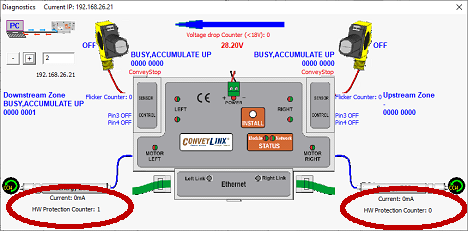Hardware Protection Counter and Flattening the Curve
As promised in my last paean that had nothing to do with PULSEROLLER, I am going to try and write about something pertaining to our products. Hopefully, you will not close this article in disgust because I am not going to wax rhapsodic upon some nonsensical topic. Perhaps, some will continue reading precisely because of this.
In the course of providing customer training, some astute students have pointed out that on our Diagnostics pop-up window in EasyRoll there is displayed a “Hardware Protection Counter” value for each motor port. (We will call this the HPC for short.)
 The even braver astute students have asked what it means. Until recently, I tap-danced around the question because I was never 100% sure myself. Usually, I would respond with “Hey, it’s bathroom break time” or “Look, a squirrel!” and hope that such a distraction would make them forget. Well, as a diligent member of PULSEROLLER academia, I set out to find the answer.
The even braver astute students have asked what it means. Until recently, I tap-danced around the question because I was never 100% sure myself. Usually, I would respond with “Hey, it’s bathroom break time” or “Look, a squirrel!” and hope that such a distraction would make them forget. Well, as a diligent member of PULSEROLLER academia, I set out to find the answer.
As it turns out, the answer is both kind of obvious based upon its name and not so obvious based upon how it affects the motor control. In the ConveyLinx module, there is circuitry that can detect high current going to each motor. Let’s call this the High Current Detection Circuit (HCDC because I am into acronyms this month). Each HCDC provides an input to the CPU indicating when it is detecting high current. However, simply because an HCDC is signaling the CPU does not mean there is an impending disaster or a problem. Under normal running circumstances, such as starting with maximum torque required or quickly changing direction, the HCDC can signal, but it is not an error or fault. It is up to the CPU to make sense of these inputs.
Part of the sense that the CPU makes from these inputs is when to raise a big red flag that it believes a motor short circuit is present. It does this by taking periodic snapshots of the status of these inputs. If enough consecutive snapshots indicate a high current within a given period of time, the CPU will decide that there is a short circuit in the motor. It will then stop the motor and the module will indicate the fault. The trick is to make sure that the period of time and number of high current snapshots strike the proper balance between over-sensitivity (which would be a nuisance tripping of the short circuit fault) and not sensitive enough that could result in motor damage.
That’s all fine and dandy for short circuit detection, but how does this relate to the HPC? Well, the HPC shows the total count of changes of state of its particular HCDC (one each for the right and left motors). This counter does not decrement or otherwise go to 0 while the module is powered up. (It resets upon initial power-up.) Thus, if the counter shows a high number, it does not mean that you are on the verge of a short circuit. It simply tells you that maybe you have undersized your motor for your application or you are otherwise controlling the motor (for example in PLC I/O mode) in a way that may not be good for the motor.
On the other hand, if the counter shows a value of 1, you could have a one-time high current event that lasted for the number of snapshots during the defined period of time that caused an actual short circuit fault.
You can think of this in a similar way to how we deal with an infectious disease pandemic and the concept of flattening the curve. If you get too many cases too quickly, then the medical system cannot treat everyone. So, if high current is analogous to an infectious disease and we get too many too fast, we stop with a short circuit fault. The HPC does not give us any information on the slope of the curve of cases or if the ConveyLinx modules’ medical system can handle all the cases. It simply gives us the total number of cases. If the ConveyLinx module has not been powered down for a long time and, thus the HPC has not been reset, you could have many cases (i.e., a big number), but never an instance when the module became so overwhelmed that it had to generate a short circuit fault.
Hopefully, this has cleared up any questions you have about what the HPC is and what it is used for. It certainly did for me and I am thankful I do not have to come up with more clever ways to divert astute students’ attention during the training class. Now if I could only find a way to get rid of that squirrel in our training room.
